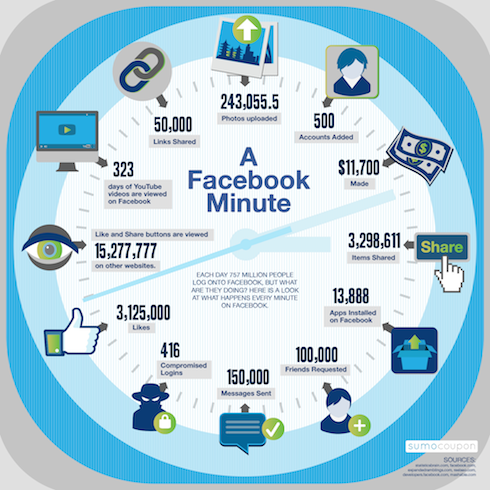By Liam Dowd - June 10th, 2014
This week's need-to-know stories in social media
In a Facebook minute
All corporations know that the activity across social media platforms can be massive. A new infographic from SumoCoupon reveals exactly what happens every minute on Facebook.
The number of ‘like’ buttons pressed is an amazing 3.1 million. Images though, continue their inexorable rise to dominance. According to this research nearly three-quarters of a million new images are added to Facebook each and every minute.
Twitter distrust
Most people have a healthy scepticism about what they read. According to new research reported in the Psychonomic Bulletin & Review, Millennials have a hard time trusting what they read on Twitter. The paper states:
“Social media sites such as Facebook and Twitter have increased drastically in popularity. However, information on these sites is not verified and may contain inaccuracies. It is well-established that false information encountered after an event can lead to memory distortion. Therefore, social media may be particularly harmful for autobiographical memory.
“Here, we tested the effect of Twitter on false memory. We presented participants with a series of images that depicted a story and then presented false information about the images in a scrolling feed that bore either a low or high resemblance to a Twitter feed. Confidence for correct information was similar across the groups, but confidence for suggested information was significantly lower when false information was presented in a Twitter format. We propose that individuals take into account the medium of the message when integrating information into memory.”
Trust as all corporations know is a currency that they need to ensure is valued by their customers. It seems that businesses have some work to do yet before some content at least that is distributed on social media networks is a trusted source of knowledge.
Instagram introducing ads
After Facebook purchased Instagram in 2012, ads have appeared on the US site. Now Instagram is expanding its ad reach to include Australia, Canada and the UK.
Debra Aho Williamson, principal analyst, social media, eMarketer said: "It's a logical next step for Instagram to roll out advertising in these English-speaking countries, enabling global brand advertisers to extend their Instagram efforts outside the US. Instagram has purposely been cautious about rolling out ads in the US, so I expect similar cautious and calculated programs in these countries."
For brand owners that have been patiently waiting for their chance to reach a wider audience with their messages, this new is highly welcome. Estimates suggest that 165 million of the 200 million Instagram users are outside of the US, making this move by Facebook an open door for corporations that want a wider target audience for their ad messages.
Millennials like the human touch
The use of social media and mobile apps for customer service has doubled since 2011, but according to NICE Systems’ Global Customer Experience Survey, 88% of customers still elect to pick up the phone and call.
“On average, customers use about six different channels to contact companies for various customer service questions, issues, or complaints – ranging from social media to email to trying to solve the problem by themselves on the company website,” said Yochai Rozenblat, President of the NICE Enterprise Group. “The usage of multiple channels continues to grow, especially in the areas of social media, online and direct chat platforms, and apps. Yet, the majority of customers still prefer to speak with a live service representative over the phone to get their issue resolved quickly.”
NICE surveyed 1,206 consumers between the ages of 18 and 65 to assess their satisfaction with customer service channels, to understand how and why customers move from one channel to the next, and to discover their behaviour and frequency of use on particular channels and how they influence brand loyalty.
Social media, live chat, and smartphone app use has doubled since 2011. Some 73% of customers have used multiple contact methods over the past six months to reach a customer service provider. While more customers are turning to emerging channels, they still prefer “live” interactions.
Also, 64% of the people using a smartphone app want it to facilitate connection to a live rep. Despite the increase in channel use, social media has a 29% success rate in resolving customer service issues as compared to 69% over the phone, and only 1% of respondents found social media to be the most satisfying channel, signifying that these modes of customer service still need improvement.
Until next time….
The Useful Social Media team.
Next Reads
June 2014, New York
Become a social business: For superior marketing response, sharper corporate decision-making, enhanced innovation and a happier, more loyal customer
Brochure Programme
